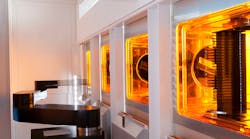Applied Materials to Help Boost Output of Silicon Carbide Chips for EVs
Applied Materials rolled out a pair of new chip-making systems to help boost the manufacturing output and drive down the cost of silicon carbide (SiC) chips that are becoming a central component of electric vehicles.
The Santa Clara, Calif.-based giant, the world's largest vendor of chip-making gear, said the tools are designed to reduce the defects in the material while increasing the wafers to 200 millimeters, which will allow the sector to boost output to fill growing global demand.
These chips are gaining ground in the power electronics that are at the heart of many aspects of electric cars, including Tesla's, such as the onboard chargers, inverters, and other parts of the powertrain. They are smaller, lighter, and more power-efficient than silicon so that EVs can travel farther on a charge. Infineon, Onsemi, ST Microelectronics, Bosch, and other firms are ramping up their production of SiC MOSFETs and other chips.
Companies such as Cree and Onsemi (formerly On Semiconductor) are investing in mass-producing wafers.
A unique property of silicon carbide is its wide-bandgap, which helps it avert electrical breakdown. These types of chips can handle vastly higher voltages—up to thousands of volts—and withstand higher temperatures than silicon. SiC also boasts less resistance, which means that it can pump out more power and dissipate less heat when transistors, diodes, or other devices manipulate, regulate, or convert electricity from one form to another.
Along with their voltage tolerance, these chips also operate at higher frequencies and more efficiently without unwanted losses of the MOSFETs or insulated-gate bipolar transistors (IGBTs) that dominate the EV segment.
The challenge it is trying to address with its new tools is that silicon carbide is inherently very tough and brittle. They are manufactured on raw wafers that are polished and used as a base for another process called "epitaxy," in which other crystalline compounds are coated on top of it to improve performance. But the wafers need to be polished perfectly smooth, or the chips will have defects that hamper performance, power efficiency, and yields.
Silicon carbide is such a tough and rigid material that manufacturers can polish only relatively small wafers—around 150 millimeters wide—without scratching the surface in a way that leads to imperfections or defects.
To combat this, Applied Materials rolled out a new tool called the Mirra Durum CMP system that can precisely polish, clean, and then dry 200-mm silicon carbide wafers to help maximize performance, reliability, and yields. Moving from 150-mm to 200-mm production roughly doubles the number of chips you can slice out of a wafer. According to Applied Materials, that will help boost the semiconductor industry's output and drive down prices.
Applied said the Mirra Durum CMP makes wafers three times smoother than previous semiconductor tools.
The other tool it introduced helps to implant a small amount of impurity (a positively or negatively charged ion called a "dopant") to a wafer, which helps improves the ability of silicon carbide chips to conduct electricity. But the density, brittleness, and hardness of silicon carbide make it a huge challenge to implant impurities without leaving behind damage that can sap the performance, power efficiency, and other properties of SiC devices.
Applied Materials solved the problem with a “hot ion” implant tool that uses scorching temperatures (500°C) to bury impurities in a silicon carbide wafer without destroying its internal anatomy, which helps to increase yields.
One of the most—if not the most—important metrics in the semiconductor industry is the yield or the fraction of chips that are not discarded during production due to severe defects. The yield directly affects chip costs.
“These products are specially designed to help our ICAPS customers take silicon carbide to larger 200-mm wafers,” said Sundar Ramamurthy, general manager of the ICAPS and packaging business units at Applied Materials. He said the automobile sector is still in the early stages of being transformed by power electronics based on silicon carbide. “This will enable them to increase output for the burgeoning demand ahead."
Every electric vehicle contains several major power building blocks—and silicon carbide is targeting them all.
The vehicle's onboard charger (OBC) in the vehicle converts AC current from the power grid to the DC current used to recharge batteries. Another major system is the inverter, which converts DC from the battery to AC to propel the electric motor driving the vehicle down the road. The dc-dc converter inside the vehicle pulls power from the battery and “steps down” the voltage to supply loads to body electronics such as headlights, power windows, seat controls, and the side mirrors. Today, these systems largely run on silicon MOSFETs or IGBTs.
Cree CEO Greg Lowe said that it is installing some of Applied's new tools in its fabs.

